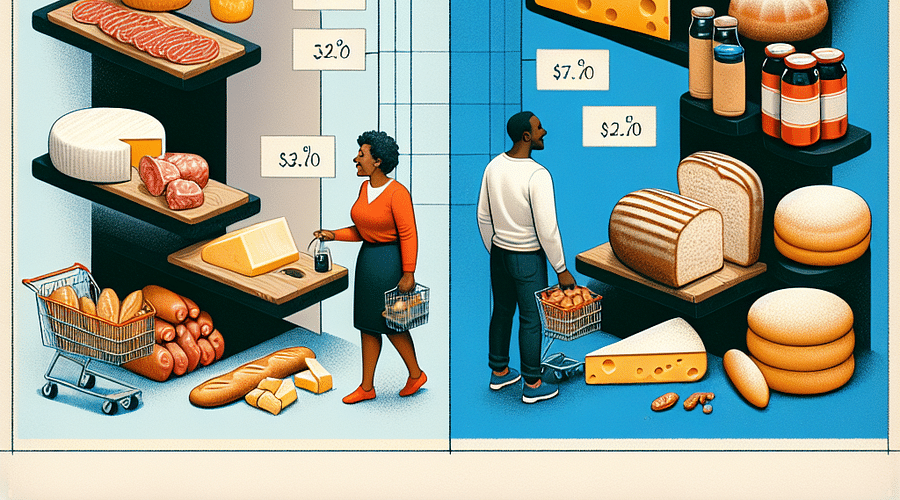Analyzing the Cost of Artisanal Foods: Is Handcrafted Really More Expensive?











For further insight into why healthier choices might seem pricier at first glance but prove economical over time, delve into discussions on topics like why healthy foods are often more expensive or the cost of healthy food in America.
To capture this sentiment visually:

The ripple effect of such support can be profound. It encourages local entrepreneurship and helps maintain traditional food-making techniques that might otherwise disappear in our fast-paced world.
In conclusion (of this first half), while there may be no simple answer to whether handcrafted is categorically more expensive than mass-produced food items, it is clear that there are layers upon layers of value wrapped up in each lovingly made morsel. From taste to nutrition to community impact—the price tag on artisanal goods reflects so much more than just food.
Stay tuned for part two where we will dive deeper into how consumers perceive these costs and explore ways to enjoy artisanal delights without breaking the bank.
When we peel back the layers of artisanal food production, we begin to appreciate the nuances that contribute to its cost. It's about more than just a price tag; it's about embracing a culture of quality, sustainability, and craftsmanship. But how does this translate into actual numbers, and is the extra expense justifiable? Let’s delve into the economics behind artisanal foods and unravel the mystery of their pricing.
At first glance, handcrafted foods may seem like a luxury reserved for those with disposable income. However, when you consider the long-term health benefits and the support of local economies, it becomes clear that these foods offer value beyond their immediate consumption. The meticulous attention to detail in artisanal food production ensures higher quality ingredients without the additives found in mass-produced goods. This often results in a product that is not only tastier but also more nutritious.
Moreover, artisanal producers are typically committed to ethical practices, including fair labor wages and eco-friendly methods. By purchasing their products, consumers are investing in responsible stewardship of the environment and contributing to a more sustainable future.
Supporting local artisans doesn't just feel good; it makes economic sense. By buying locally produced foods, you're keeping money within your community, which helps stimulate local economies and create jobs. This cycle of support fosters growth and innovation within the artisan sector, leading to more diverse and high-quality food options for consumers.










This support also encourages small-scale producers to maintain traditional techniques that have been passed down through generations. In doing so, they preserve cultural heritage and offer a unique experience that can't be replicated by large-scale operations.
To truly understand why artisanal foods often come with a higher price tag, one must look at the comparison with their mass-produced counterparts. Large corporations benefit from economies of scale—bulk purchasing and automated processes—that significantly reduce their cost per unit. Artisans, on the other hand, often source premium ingredients from small suppliers at a higher cost and invest considerable time into each batch they produce.
The difference is also palpable when it comes to taste and quality. For instance, consider chocolate—a product where quality can vary immensely. Higher-end artisan chocolates, crafted with fine cacao beans and minimal additives, offer an incomparable taste experience compared to commercial brands heavy on sugar and preservatives.
In many cases, consumers find that despite being more expensive upfront, artisanal foods offer greater satisfaction and longevity—meaning less frequent purchases than one might expect with cheaper alternatives.
Finding balance is key when it comes to incorporating artisanal foods into your lifestyle without breaking the bank. One strategy is to prioritize which items are worth investing in based on your personal values—be it flavor, health benefits or supporting local businesses.
You don't have to overhaul your entire pantry at once; even small changes can make a significant impact over time. Perhaps start by swapping out your regular coffee for beans from a local roaster or choosing handcrafted cheese for your next dinner party.
In essence, while artisanal foods may carry a higher initial cost, their value cannot be solely measured in monetary terms. The rich flavors, health benefits, ethical production standards, and positive impact on local communities all contribute to their true worth. As consumers become more informed about what goes into making these products—and why they're priced as they are—they can make purchasing decisions that align with both their budgetary constraints and their values as responsible citizens of our global community.
In summary, handcrafted foods indeed come with a price—but one many find justified given the exceptional quality they deliver on multiple fronts. Whether you're savoring an exquisite piece of cheese or biting into freshly baked sourdough made from heirloom grains, remember that each purchase supports not just your palate but also passionate artisans who are dedicated to bringing you excellence in every bite.
Post a comment